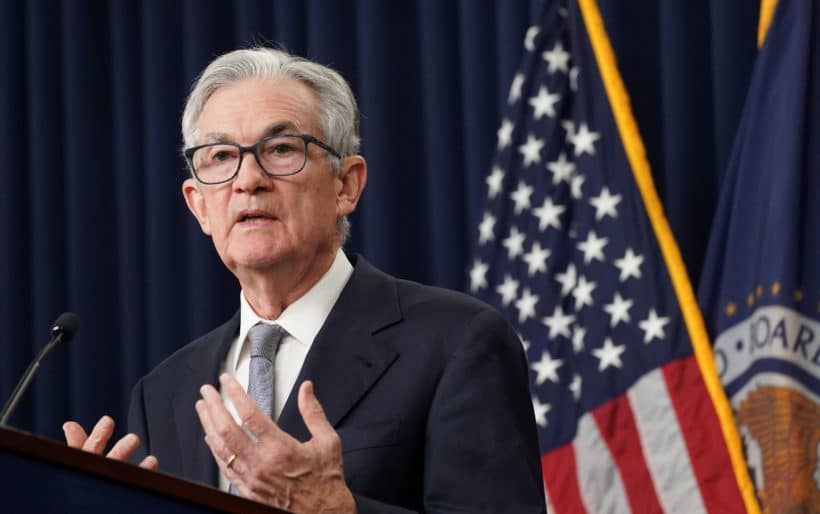
The Federal Reserve on Wednesday again held benchmark interest rates steady amid a backdrop of a growing economy and labor market and inflation that is still well above the central bank’s target.
In a widely expected move, the Fed’s rate-setting group unanimously agreed to hold the key federal funds rate in a target range between 5.25%-5.5%, where it has been since July. This was the second consecutive meeting that the Federal Open Market Committee chose to hold, following a string of 11 rate hikes, including four in 2023.
The decision included an upgrade to the committee’s general assessment of the economy. Stocks rallied on the news, with the Dow Jones Industrial Average gaining 212 points on the session.
“The process of getting inflation sustainably down to 2% has a long way to go,” Fed Chair Jerome Powell said in remarks at a news conference. He stressed that the central bank hasn’t made any decisions yet for its December meeting, saying that “The committee will always do what it thinks is appropriate at the time.”
Powell added that the FOMC is not considering or even discussing rate reductions at this time.
He also said the risks around the Fed doing too much or too little to fight inflation have become more balanced.
“This signals that while there is a potential risk for the Fed to do more, the bar has become higher for rate hikes, and we are clearly seeing this play out with two consecutive meetings of no policy action from the Fed,” said Charlie Ripley, senior investment strategist at Allianz Investment Management.
Economy has ‘moderated’
The post-meeting statement had indicated that “economic activity expanded at a strong pace in the third quarter,” compared with the September statement that said the economy had expanded at a “solid pace.” The statement also noted that employment gains “have moderated since earlier in the year but remain strong.”
Gross domestic product expanded at a 4.9% annualized rate in the third quarter, stronger than even elevated expectations. Nonfarm payrolls growth totaled 336,000 in September, well ahead of the Wall Street outlook.
There were few other changes to the statement, other than a notation that both financial and credit conditions had tightened. The addition of “financial” to the phrase followed a surge in Treasury yields that has caused concern on Wall Street. The statement continued to note that the committee is still “determining the extent of additional policy firming” that it may need to achieve its goals. “The Committee will continue to assess additional information and its implications for monetary policy,” the statement said.
Wednesday’s decision to stay put comes with inflation slowing from its rapid pace of 2022 and a labor market that has been surprisingly resilient despite all the interest rate hikes. The increases have been targeted at easing economic growth and bringing a supply and demand mismatch in the labor market back into balance. There were 1.5 available jobs for every available worker in September, according to Labor Department data released earlier Wednesday.
Core inflation is currently running at 3.7% on an annual basis, according to the latest personal consumption expenditures price index reading, which the Fed favors as an indicator for prices.
While that has decreased steadily this year, it is well above the Fed’s 2% annual target.
The post-meeting statement indicated that the Fed sees the economy holding strong despite the rate hikes, a position in itself that could prompt policymakers into a prolonged tightening stance.
In recent days, the “higher-for-longer” mantra has become a central theme for where the Fed is headed. While multiple officials have said they think rates can stay where they are as the Fed assesses the impact of the previous increases, virtually none have said they are considering cuts anytime soon. Market pricing indicates the first cut could come around June 2024, according to CME Group data.
Surging bond yields
The restrictive stance has been a factor in the surging bond yields. Treasury yields have risen to levels not seen since 2007, the earliest days of the financial crisis, as markets parse out what is ahead. Yields and prices move in opposite direction, so a rise in the former reflects waning investor appetite for Treasurys, generally considered the largest and most liquid market in the world.
The surge in yields is seen as a byproduct of multiple factors, including stronger-than-expected economic growth, stubbornly high inflation, a hawkish Fed and an elevated “term premium” for bond investors demanding higher yields in return for the risk of holding longer-duration fixed income.
There also are worries over Treasury issuance as the government looks to finance its massive debt load. The department this week said it will be auctioning off $776 billion of debt in the fourth quarter, starting with $112 billion across three auctions next week.
During a recent appearance in New York, Powell said he thinks the economy may have to slow further to bring down inflation. Most forecasters expect economic growth to tail off ahead.
A Treasury Department forecast released earlier this week indicated that the pace of growth likely will tumble to 0.7% in the fourth quarter and just 1% for the full year in 2024. Projections the Fed released in September put expected GDP growth at 1.5% in 2024.
In the wake of the Fed’s comments, the Atlanta Fed’s GDPNow growth tracker slashed expectations for fourth-quarter GDP almost in half to 1.2% from 2.3%. The gauge takes in data on a real-time basis and adjusts its estimates with the latest information.
Whitney Watson, co-CIO of fixed income and liquidity solutions at Goldman Sachs Asset Management, said it’s likely the Fed will keep its policy unchanged into next year.
“There are risks in both directions,” Watson said. “The rise in inflation expectations, owing to higher gas prices, combined with strong economic activity, preserves the prospect of another rate hike. Conversely, a more pronounced economic slowdown caused by the growing impact of higher interest rates might accelerate the timeline for transitioning to rate cuts.”